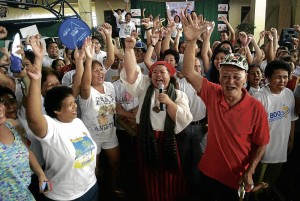
KRUS na Ligas residents in Quezon City on Sunday joined hands with comedian-on-a-crusade Juana Change (center, wearing scarf) in bringing to the attention of the public a reported plan to build an annex of a barangay (village) hall on the spot where Katipunan head Andres Bonifacio and his men found refuge away from Spanish colonial authorities in the late 19th century. Bowing down to pressure, proponents of the measure decided to junk the project. ARNOLD ALMACEN
The Quezon City councilor who approved the construction of a two-story building on the historic plaza where the hero Andres Bonifacio and his fellow Katipunero sought refuge has shelved the project, following a protest by residents and members of the No More Epal Movement.
On Sunday, the No More Epal Movement took up the cause of the barangay (village) residents in its first preemptive strike against politicians who take credit for government-funded projects by putting their names on tarpaulins and billboards.
In a dialogue with Holy Cross Parish priest Ron Roberto and other residents of Barangay Krus na Ligas, Fourth District Councilor Vincent Belmonte said he had been misinformed about the project at Plaza Sta. Ines proposed by barangay chairman Julian Santos.
Museum envisioned
Roberto quoted Belmonte as saying that the barangay chairman had told him that the new building would be a museum, so he agreed to allocate P3.2 million for its construction on a historic place.
The parish priest told the Inquirer that it was the first time the councilor heard what the residents really thought of the project and the true purpose of the construction.
“He (Belmonte) was surprised when we informed him that the building was to be used as a barangay office with a garden and a veranda for flag raising ceremonies,” Roberto said.
He added that Belmonte had described the project as “self-serving,” and decided to stop the construction.
Apart from pulling the plug on the project, the National Historical Commission of the Philippines (NHCP) had also intervened.
In a letter dated October 29 to Mayor Herbert Bautista, NHCP chairperson Maria Serena Diokno “strongly” urged him and other local officials to listen to the clamor of the residents and abandon the construction until a proper dialogue with the stakeholders is held.
“The National Historical Commission of the Philippines recognizes that Krus na Ligas is historic, having been a place of refuge for Andres Bonifacio and the Katipuneros in 1896. Our concern is the preservation of the town plaza, small as the space is in Krus na Ligas,” Diokno wrote.
She added: “The town plaza could well be the only remaining space for the community and it must be preserved.
“If it is built up, the ventilation of the area will be compromised, residents will be denied the little space they have to enjoy the grounds and the cramped plaza could pose a danger in case of an emergency or a disaster. Imagine life in this century if no free space were available for future generations of Krus na Ligas residents.”
Available space
Diokno instead proposed that the second floor of the existing barangay hall be cleared of unserviceable equipment and furniture so it can be used as office space for the barangay officials.
The Holy Cross Parish priest told the Inquirer that Barangay Krus na Ligas residents were assured that the P3.2 million for the construction of the two-story building would be allocated for a project that would best benefit the entire community.
“I would give credit to and thank Councilor Belmonte for hearing us out and preserving the plaza. He was really not at fault,” Roberto said.
According to the parish priest, the next step was for reconciliation in the barangay. “It (the construction) was a divisive issue and caused a conflict between families here, which is not good for a community. We would have to meet and reconcile differences and I would ask them not to hate the person but the wrong act or decision he made.”
Plaza Sta. Ines is where Bonifacio and other Katipuneros briefly rested on Aug. 26, 1896, to gather their bearings and strategize following a clash with Spanish soldiers at Pasong Tamo.
It is also the site of the church of Holy Cross Parish, the second-oldest church in Quezon City.